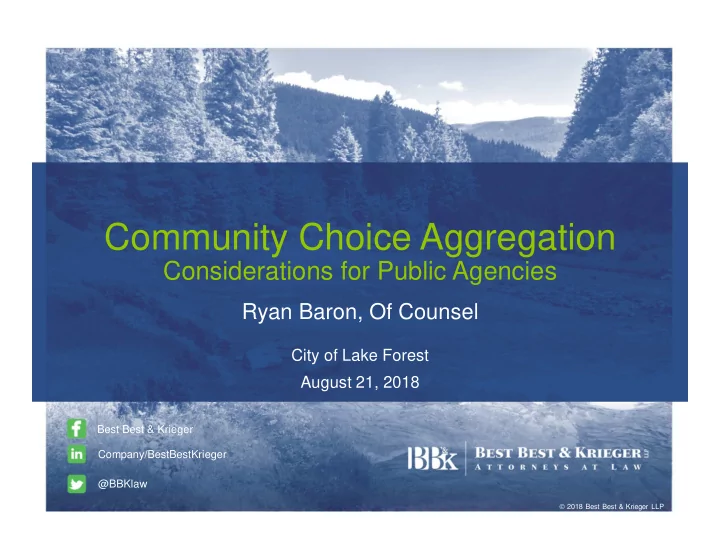

Community Choice Aggregation Considerations for Public Agencies Ryan Baron, Of Counsel City of Lake Forest August 21, 2018 Best Best & Krieger Company/BestBestKrieger @BBKlaw 2018 Best Best & Krieger LLP
What is community choice aggregation? • Allows cities, counties, and cities and counties through a joint powers authority to aggregate the electric load of their residents and businesses and provide retail electricity (AB 117, Migden, 2002) • Buy wholesale power through power purchase agreements (PPAs) and/or generate power • Also known as community choice energy
Why was CCA adopted? • Law was passed during California energy crisis allowing communities to purchase wholesale power and/or generate local power • An alternative to forming a municipal electric utility and condemning existing utility transmission and distribution • Retail electricity is a natural monopoly. Large institutional consumers can participate in Direct Access market but residential and most business consumers don’t have choice in electric providers • PG&E, SCE, SDG&E
Reasons to Form • Provide residents with lower energy rates (generation) than the IOU • Allow customers to purchase higher renewable power content • Economic development tool • Local control • Develop local power sources • Offer energy efficiency, conservation and climate change programs
Average Retail Price in California $0.1523 kWh
Governance Structure • CCA structure can be individual city or county (enterprise fund) • Joint powers authority (JPA) – cities and county • Special legislation • Sonoma County Water Authority • Kings River Conservation District • Public agency that has authority to provide retail power can provide to cities contiguous to it • In-house management, consultants, turn-key models
Basic Steps • Feasibility study • Public deliberation period • Pass ordinance or resolution • Form enterprise fund or JPA • CPUC approved implementation plan • Customer outreach • Launch
Customers, Billing & Collections • Residents and businesses are automatically enrolled in CCA (ordinance) • Customer must affirmatively opt-out • CCA provides two notices prior to enrollment and two notices after enrollment • Opt out within 60 days after service commences with no charge • Customer must wait 12 months before returning to CCA • IOU provides all metering, billing and collection • IOU provider of last resort
SCE-CCA Bill • https://goo.gl/3D1esw (sample SCE-CCA bill)
Business Considerations • What is the City’s projected load? • What types of ratepayers are within the City? • What are current and projected energy prices? • Are there projected savings? • What are market risks? • Do City ratepayers desire higher renewable products? • Is the City interested in retaining CCA revenues for CCA related projects and programs? • Would a CCA be managed by the City, through a JPA, consultant turnkey or some other mechanism? • Administrative costs
Legal and Liability Considerations • Governance structure • Solely responsible for all generation procurement • Must serve all residential customers • Proposition 26 and rate setting • Liability to City General Fund? • Termination of CCA program – obligation to buy power once procured • Creditworthiness for long-term power agreements • Risk management policy • Withdrawal from JPA prior to launch
Regulatory Considerations • CPUC registration timelines for CCAs (CPUC Resolution E-4907) – Implementation plan submitted to CPUC one year prior to launch • Participation in CPUC’s year-ahead Resource Adequacy planning process • IOU exit fees (power charge indifference adjustment) – customer indifference • Load forecast and GHG reduction filings • Integrated resource planning filings (IRP) • Renewable portfolio standard filings (RPS)
2018 PCIA Exit Fees PG&E SCE SDG&E Residential 0.03346 0.01877 0.02547 Small Commercial 0.02466 0.01204 0.02613 Medium Commercial 0.02502 0.01565 0.02033 Large Commercial 0.02104 0.01296 002033 Industrial 0.01888 0.01049 0.02033 Lighting 0.00589 0.00002 0.00000 Agriculture 0.02463 0.01165 0.01441
Questions? Ryan Baron Of Counsel Best Best & Krieger LLP Offices: Irvine/Los Angeles 949-263-6568 ryan.baron@bbklaw.com www.bbklaw.com
Recommend
More recommend